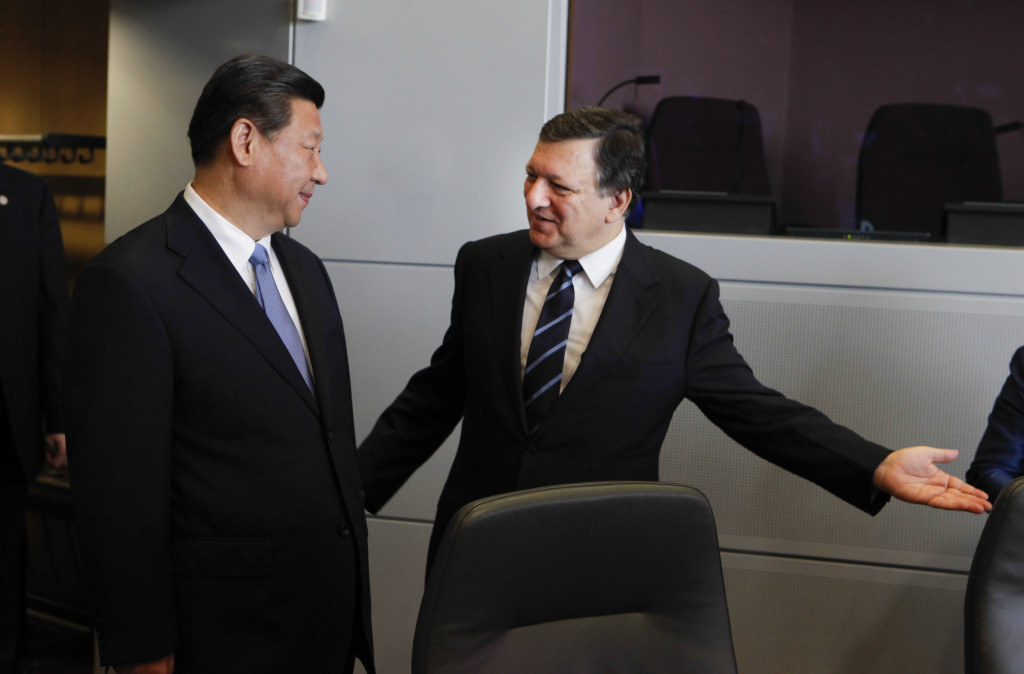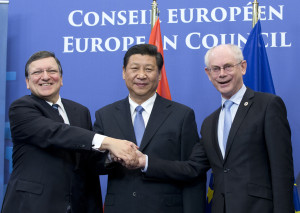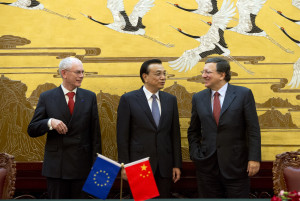In this article Axel Berger of the German Development Institute takes a broad view of the current EU-China investment negotiations with respect to other international processes. By placing the negotiations in the context of an EU-China-US power triangle, he explains that the eventual outcome should be embedded in a global dialogue on investment policies.
Since January 2014 the European Union (EU) and China have been negotiating an international investment agreement (IIA). This treaty should replace the current legal patchwork consisting of 26 different bilateral investment treaties that individual EU member states have negotiated with China during the past three decades.
China and the EU are aiming at further boosting foreign direct investment (FDI) between both regions. During the last decade investment flows have increased not only from the EU to China but also in the other direction. Yet compared to the intense bilateral trade relationship bilateral investment flows remain rather small.
Beyond the immediate goal of increasing FDI the negotiations are of significance because they are a test case for both partners’ new approaches towards negotiating IIAs and are acknowledged as a stepping stone towards a much bigger project—an EU-China free trade agreement. At the same time, a future European-Chinese investment treaty will form part of a power triangle between the EU, China and the US, in which the rules of global investment are in the process of being redefined calling for an accompanying global dialogue on investment rule-making.
Investment treaties traditionally adhered to a simple logic: their intended aim was to provide a legal framework for developed countries’ investments in developing countries, potentially leading to increased investments. These treaties typically contain clauses against discriminatory and unfair treatment of foreign investors, guarantee the free transfer of capital and regulate direct and indirect expropriations. In addition, foreign investors gain the opportunity to bring breaches of treaty provisions before international arbitration tribunals.
With the exception of Ireland, all EU member states have concluded bilateral investment treaties with China following this traditional model. Under closer scrutiny, however, these treaties vary considerably in terms of the level of protection granted to foreign investors.
The first Chinese investment agreement was signed in 1982 with Sweden.[1] In the following years, China negotiated a number of additional agreements with European countries sending out a signal that foreign investments are welcome as part of the Chinese ‘reform and open-up’ policy. This first generation of Chinese investment agreements, negotiated throughout the 80s and 90s, however, included various safeguards, most importantly regarding the possibility of foreign investors initiating international arbitration. Some European countries’ agreements with China are still based on this restrictive model.
In the late 1990s China introduced a new model for its investment agreements that included, inter alia, comprehensive investor-state dispute settlement and less restrictive national treatment clauses. A number of European countries updated their old treaties with China to this new level of investment protection during the 2000s. One aim of an EU-wide IIA with China is to replace these different bilateral treaties and create a coherent legal framework for mutual investment flows.
Entering uncharted waters
Both China and the EU are entering unchartered waters with this new treaty. From a European perspective, the IIA negotiations with China are one of the first pieces of an emerging web of investment rules being negotiated with large economies—often in the context of trade agreements. The inclusion of market access provisions—in the form of pre-entry national treatment that ensures that foreign investors have the same market access as domestic investors—is the decisive element in the package being negotiated with China. If successfully concluded, the investment agreement will constitute a stepping stone towards a comprehensive free trade agreement between China and the EU.
For China, the IIA negotiations with the EU—and in parallel with the US for that matter—come at a crucial phase of economic development. The new Chinese leadership, under President Xi Jinping and Premier Li Keqiang, has embarked upon an ambitious programme of reform that should result in the extensive dismantling of barriers to foreign investments in China—a tangible example of this is the recently launched China (Shanghai) Pilot Free Trade Zone in which investors are granted enhanced market access on the basis of a negative list approach for exceptions. An EU-China investment agreement would place further pressure on China to actually bring these reforms to fruition.
In addition to the challenge of negotiating enhanced market access for foreign investors, China and the EU will also have to take into account the recent calls seeking for a better balance between the rights granted to foreign investors and the ability of host states to regulate FDI in the public interest. On the one hand, this recent turn of international investment rule-making is a result of the fact that foreign investors have been initiating numerous claims against host states.[2] The recent discussion in Europe on the benefits and drawbacks of investor-state dispute settlement in the context of the Transatlantic Trade and Investment Partnership (TTIP) are just the most recent example in this respect.[3]
On the other hand, it is not only the increasing number of international arbitration cases that define the background against which China and the EU are negotiating a new set of investment rules. A second driver that calls for a re-balancing is the fundamental shift in global FDI flows as companies from emerging countries, especially China, are increasingly investing in developed countries, too. Notably, in 2011, outflows from China to the EU have overtaken those from the EU to the Middle Kingdom.[4] In other words, both China and the EU have to balance their interests as source and receiving economies of foreign investments. China, in its most recent IIAs and trade agreements negotiated with countries from the Americas and Asia, has already made a step into this direction[5] and so will the EU in the context of its trade agreement to be finalised with Canada.
The investment negotiations are surely of great significance for EU-China economic relations. However, the significance of the negotiations between the EU and China extends beyond the bilateral relationship itself. For some years now China has also been negotiating with the US on an investment treaty that is to take a similar form to the European-Chinese agreement. In addition, the TTIP between the US and Europe will most likely comprise a comprehensive investment chapter. In all three treaties provisions are being negotiated that should lead to the further liberalisation of investment flows. Rules regarding market access, the prohibition of performance requirements and transparency rules for state-run companies will consequently be elevated to a de facto global standard.
It should be in the interests of companies and decision makers of the three economic powers to place these negotiations on a broad footing and take account of the interests of those countries that are not sitting at the negotiating table. Today, transnational companies operate within the scope of global value chains that extend far beyond the triangle described here. Current developments in emerging countries such as South Africa and India show a stance of increased hostility against IIAs. The investment negotiations between the EU, the US and China should therefore be accompanied by a global investment dialogue process,[6] which will in turn contribute to achieving a global consensus regarding investment policy.
Axel Berger is a researcher at the German Development Institute/Deutsches Institut für Entwicklungspolitik (DIE), Department for World Economy and Development Finance, Bonn. He works on global investment policies, with a focus on emerging and developing countries. His current major areas of research are the diffusion patterns and development impacts of international investment agreements.
[1] On China’s BIT policy see e.g. Axel Berger (2011): The Politics of China’s Investment Treaty-Making Programme, in: Tomer Broude / Amelia Porges / Marc Busch (eds.): The Politics of International Economic Law, Cambridge, M.A.: Cambridge University Press, pp. 162-185.
[2] The United Nations Conference for Trade and Development counts 568 known investor-state dispute settlement cases at the end of 2013. See UNCTAD (2014): Recent Developments in Investor-State Dispute Settlement (ISDS), IIA Issues Note No. 1, April 2014, online: (accessed: 22.4.2014).
[3] See Axel Berger (2014): The transatlantic free trade agreement – the dispute over dispute settlement, German Development Institute, The Current Column of 4th March 2014: (accessed: 22.4.2014).
[5] See Axel Berger (2013): Investment rules in Chinese preferential trade and investment agreements: is China following the global trend towards comprehensive agreements? German Development Institute, Discussion Paper 7/2013, (accessed: 22.4.2014).
[6] Karl Sauvant and Federico Ortina (2013): The need for an international investment consensus-building process, Columbia FDI Perspectives No. 101, August 12, 2013 (accessed: 22.4.2014).





Recent Comments